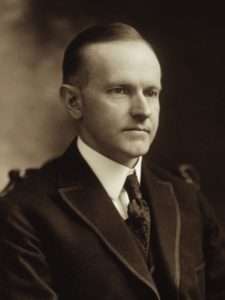The Volokh Conspiracy
Mostly law professors | Sometimes contrarian | Often libertarian | Always independent
Today in Supreme Court History: August 2, 1923
8/2/1923: President Calvin Coolidge's Inauguration. He would appoint Justice Harlan Fiske Stone to the Supreme Court.

Editor's Note: We invite comments and request that they be civil and on-topic. We do not moderate or assume any responsibility for comments, which are owned by the readers who post them. Comments do not represent the views of Reason.com or Reason Foundation. We reserve the right to delete any comment for any reason at any time. Comments may only be edited within 5 minutes of posting. Report abuses.
Please to post comments




West v. Barnes was the first Supreme Court decision.
The case was of some note. The dispute involved the use of paper currency instead of gold and silver to pay for a farm mortgage. So, it had some constitutional implications.
The case, argued on 8/2/1791 (a decision handed down the next day), ultimately turned on a procedural point. West, by federal law, had to have a writ signed within ten days by a Supreme Court clerk.
The clerk was in Philadelphia, and the West was in Rhode Island. It would be far from easy to make the trip on time in those days. But the law was the law.
West lost on the procedural ground, but Congress soon changed the law to address the problem. The decision did not end matters, which lingered on until after his death. His heir lost West v. Randall (1820), an important precedent in class actions.
==
President Harding died on 8/2/1923, but Coolidge was not sworn in (by his father) until early morning the next day.
https://www.inaugural.senate.gov/swearing-in-of-coolidge/
Harlan Stone was serving as Attorney General when President Coolidge appointed him to the Court in 1925. Chief Justice Taft had lobbied Coolidge to appoint Stone to the Court, an endorsement he would soon come to regret.
In April 1929, Taft wrote his son Charles:
A few months later, Taft wrote his brother Horace:
Taft would eventually step down from the Court on February 3, 1930, after receiving assurances from Hoover that he would appoint former Justice Charles Evans Hughes, rather than Stone, to succeed him. Taft would die on March 8, a little more than a month after stepping down from the Court. Stone would, of course, become Chief eleven years later when President Franklin Roosevelt would appoint him to the position.
1. Henry F. Pringle, 2 The Life and Times of William Howard Taft 1044 (1939).
2. Id. at 967.
Hughes was a progressive as well, although I guess not a potential Bolshevik. Taft also appointed Hughes to the Court as associate justice, so two of his appointments went on to be Chief Justice. I also think Taft was correct; Hughes was a much better appointment.
"Silent Cal" didn't do much, but there wasn't much people wanted him doing.
Someone earlier this week, in the comments to one of these posts, O/T flagged a new memo regarding religious expression at the workplace.
I noted that it seemed generally benign, though I was somewhat wary about the proselytizing aspects. Stephen Colbert referenced it in a monologue.
Upon further review, I still think it is benign in various respects (people should be able to have the ability to express some religious expression at work), but I am wary about certain applications.
https://ffrf.org/news/releases/office-of-personnel-management-religion-workplace-changes-shockingly-unconstitutional/
https://religionclause.blogspot.com/2025/07/office-of-personnel-management-says.html
Harlan Stone seems to have been Coolidge's David Souter.